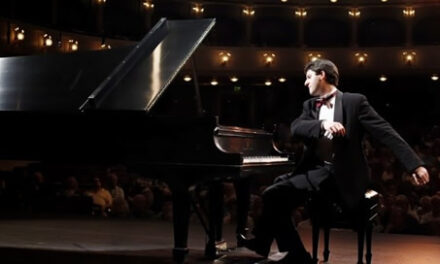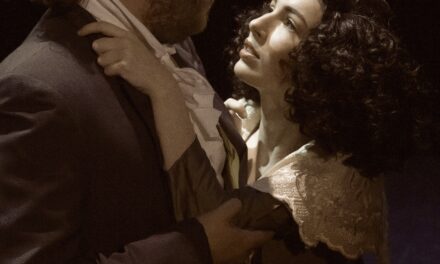Late in 2008, when I interviewed North Carolina Dance Theatre artistic director Jean-Pierre Bonnefoux and his associate director, Patricia McBride, for a feature in Dance International, McBride was already gushing in anticipation of the NCDT premiere of George Balanchine’s Apollo – and almost blushing as she recalled husband Bonnefoux’s performance of the title role when both were New York City Ballet superstars. “Jean-Pierre was a wonderful Apollo!” she exclaimed girlishly, leaving Bonnefoux momentarily flustered. A good-sized crowd at Knight Theater discovered what the excitement was all about as McBride staged the piece with its famed Stravinsky score.
If David Ingram hadn’t already established himself among the elites of NCDT’s men, alongside Sasha Janes and Addul Manzano, then his elegance and grace in the Apollo certainly cemented his position. After an impressive solo introduction, “The Birth of Apollo,” Apollo dances in more than half of the sections – there are ten in all – in Balanchine’s choreography, and he’s the appreciative audience for most of the rest as Calliope, muse of epic poetry, Polyhymnia, muse of singing and mime, and Terpsichore, muse of dance, display their respective charms. Of course, he partners them all – sometimes simultaneously! – yet he must also be their dancing equal.
Three of NCDT’s top women were the muses, with Traci Gilchrest as Terpsichore (who naturally usurps the role of leading muse in Balanchine’s mythology), Alessandra Ball as Polyhymnia, and Anna Gerberich as the demoted Calliope. Individualism is a hallmark of this company, yet I have never seen such precise ensemble synchronicity as I witnessed when the muses were called upon to dance in unison. Gerberich led off solos, tossing away a writing tablet as Calliope moved downstage. Ball tossed away a tragic mask before providing a brief oasis of comic relief, assuming Poly’s traditional attitude, left index finger to her mouth to emphasize her personification of mime. As Terpsichore, Gilchrest held up a lyre – also Apollo’s characteristic emblem – before her solo, exited at the opposite wing from her predecessors, and was gifted with a regal pas de deux, partnered with Ingram, before Calliope and Polyhymnia returned. The fact that Ball and Gerberich look so much alike made the casting beyond perfect, and as the four dancers formed the closing sun tableau, the satisfaction of finally seeing this dance in Charlotte surely matched McBride’s satisfaction in presenting it.
Amazingly, the rest of the evening wasn’t anticlimactic. While this wasn’t the first presentation of Mark Godden’s Constructing Juliet, the concept at Knight Theater was dramatically sharper than it had been when NCDT last presented it at Booth Playhouse in 2008. Sasha Janes and Rebecca Carmazzi, husband and wife in real life, brought their special chemistry to the Romeo/Juliet interludes that punctuate the true core of the piece: the Capulets’ ritualized hatred of the Montagues. That ritual has two distinct parts, best demonstrated by Gilchrest as Lady Capulet. First we hear a savage warlike ululation, followed by a scornful spitting into a ceremonial urn. Tensions between Juliet and her barbaric family are so dominant in this piece that, when we arrive at the famed love theme in Tchaikovsky’s Romeo and Juliet Overture Fantasy, Carmazzi is decisively renouncing the clan ritual in its second, more elaborate presentation rather than spooning with her Romeo.
In Godden’s most dramatic departure from the Shakespearean scenario, the Capulets actually seem to discover Juliet’s liaison with Romeo, which has finally blossomed with the reprise of the love theme. The black-clad Capulets assemble angrily and Juliet approaches the ceremonial urn for the last time. She lifts it and drinks all of the family’s hateful saliva, decorously dying of the poison. As the Capulets lie prostrated in grief, Romeo – the lover who actually poisons himself in the original drama – comes scampering in, scattering roses over all of his enemies and saving one last rose for Juliet. Oozing the rhapsodic spirit of the music, Janes’ final entrance as FTD courier somehow made the whole piece click for me at last in my third viewing.
The program ended with a world premiere of Dwight Rhoden’s Broken Fantasy, circling us back to the music of Stravinsky, his Symphony in Three Movements. With his starring role in this piece at the end of his first season with the company, Max Levy has laid firm claim to the niche once held by Servy Gallardo, that of the company’s lovably mischievous pipsqueak. Here among six strange couples, Levy was the conspicuous outsider, shorter than his fellow satyrs but also more scantily clad, in a distinctly lighter shade, by costume designer Christine Darch. Levy’s attentions were mostly directly toward stealing Ingram away from Kara Wilkes, quite possibly the tallest of the females. For the middle section of the dance, done to no music at all (perhaps because of a cuing problem in the sound booth?), only the core triangle were left onstage, concentrating Levy’s efforts and heightening his frustration. What Wilkes and the other ballerinas might have been is open to conjecture. Tinkerbells with Goth makeup and coloring might be an apt description, but their ultimate effect on their men-folk was akin to that of imperious insects, more sinister and Dionysian. Perhaps Levy was lucky that he was too small, light, or young to gain their favor.












